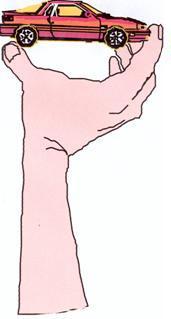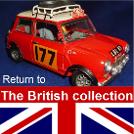
Morris Minor 1961 “Panda”
Two cars roll on British roads that are almost universally recognised and loved. The Morris Minor and the “Mini” Minor. Both the Minor and the Mini were designed by Sir Alec Issigonis and they are proof that the Issigonis mantra of “Space for passengers and payload, not mechanicals” appealed to the burgeoning throng of car owners with minimal mechanical knowledge but growing ambitions to be treated on equal terms as the upper classes, those who enjoyed the freedoms of motoring simply because they could afford it. It probably never occurred to Issigonis that either of these cars would be purchased and loved just as much by the rich and famous as they were buy the man in the street. While Issigonis and his team would later go on to the greater feat of engineering the “Mini”, Sir Alec’ was most proud of the Morris Minor.
The Morris Minor 1000 series (1956 to 1971)
The car that became the much-loved Morris Minor 1000 arrived in October 1956. The split screen was swapped out for a larger one-piece front windscreen and the rear window became bigger too. There was an overlapping period were the previous clap-hands windscreen wiper system of the split screen cars remained in service until eventually moving to the now conventional pairing system. all round visibility was excellent, in the dry at least. Other visible differences include smaller rear wheel cut outs, larger front side-light/indicator and rear-light/indicator combo’s. New “Minor 1000” logos for the bonnet sides and the boot lid.
On the inside the dashboard layout was upgraded with one, or even two, lids for the glove boxes, not that the one on the driver’s side was actually helpful! The steering column was redesigned to house the indicator stalk rather than the earlier, slightly awkward, switch under the dash arrangement. A new heater was fitted with a different frontage and the more modern two spoke black steering wheel replaced the dished wire spoke one. Other changes included the gear lever and handbrake being reduced in size, the gear lever moved backwards and the handbrake moved forwards to make a more ergonomically correct layout.
The Minor 1000 title was marking the new version of the A series engine now being installed. 948cc of inline four-cylinder engine provided 37hp @ 4,750 rpm. At the same time a new gearbox was also fitted and suddenly the nimble little car was quite nippy too. Being able to maintain higher speeds was not only a boon on the new British Motorways.
As a matter course the Minor 1000 was constantly being improved. Fuel capacity was increased in March 1957 with a larger six-and-a-half-gallon tank replacing the old five gallon’ one. It did push its way into the boot space a little but journeys could now be extended and worrying about the fuel level was a little less urgent. The ride was softened by reducing the rear springs from seven to five leaf units; although this did have a less than positive effect on the cars handling characteristics.
In 1959 the interior was the centre of attention a wider parcel shelf fitted under the dash’ and the horn button was relocated to a much more convenient position in the centre of the steering wheel. Indicator stalks became self-cancelling and had a large green repeater bulb on the end of the stalk. I a small upgrade of the exterior all road wheels and grills were painted pearl grey.
Evolutionary changes continued through the Minors life. In 1961 the semaphore type trafficators were replaced by modern flashing indicators. These were combined into new larger lighting units front and rear, the front combined the side lights and indicators, the rear as one cluster in which the indicators made up about a third of the unit so the new rear lights are a third as big again as the out ones. Two-tone Vynide upholstery replaced leather on the deluxe range, standard range was the same but in single colour. In another odd reversal the lids for the glove boxes were dropped leaving open storage again.
More than 1.6 million Morris Minors, in all its variants, were produced in a production run of over two decades between 1948 and 1971.
The Morris Minor proved to be an attractive model for all manner of commercial work. Vans and pickups were used by traders and the large companies like the Royal Mail Post office and GPO telecommunications. Many police forces also used the Minor 1000 as a general purpose and patrol car. Ian built this model in a rush for the 2018 Scale model world show. In just 7 days Ian built the model and wrote the instructions for the first eight kits to go on sale at SMW 2018. Although not fully finished until after the show this model was the first built from the kit and promises a lot of fun for other builders now the kit is on sale.
This model
For the sake of building something different to Rod’s civilian Minors and Ian’s BMC team Rally Minor Ian chose to use a Police colour scheme. This number plate and appearance is from a “Panda” car that was used by the Wolverhampton Borough Police force in Wolverhampton (then still in Staffordshire), England, but the plate is actually a 1964 reg’. Some poetic licence is thus applied for the sake of making an interesting model and showing the potential of the kit.











Although there have been many models of the Minor from diecasts, toys, and scale model kits for some reason a 1/24th scale version has never been made on a production level. This model started as just a resin body shell purchased by Ian, for Rod, in 2015. It disappeared into his collection but resurfaced during 2017. Rod then did a lot of scratch building and between Rod and Ian the body was totally reworked and a full resin model kit produced. The first prototype model kit proved over complicated and was reworked through 2018 before going way to be professionally moulded and cast in resin.
Kit # MMiM 124001 this kit was the first model kit released by us, the Motor Museum in Miniature. In cooperation with Coastal Craft and their new range of “Race Craft” kits the Morris Minor kit went on sale at the 2018 IPMS (UK) Scale Model World show.
The model is finished with a custom mix of Deco-Art paints and Zero paints clear lacquer. Humbrol enamels and acrylic paints from Citadel and Deco-Art have been used for the interior and detail painting. Bare metal foil has been used on the chrome work along with Molotow liquid chrome pens for the smaller parts. Number plate decals are sourced from an online auction house. The lightbox and blue light shell were scratch built for the model, as usual moulds were taken and castings made so the possibility of a Police conversion set being made available so other modellers can turn their Morris Minor into one of the many cars used by Police forces across Great Britain.
